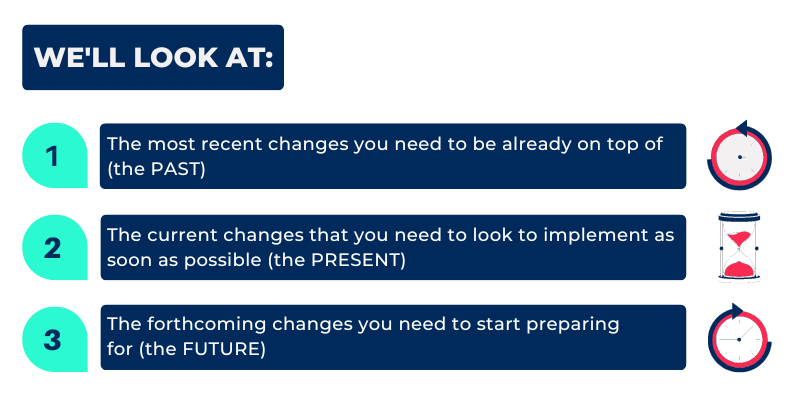Campus Recruiting: The Past, The Present, and The Future

Can you remember any other time in your life when world events were changing the way we all live and work so quickly and so dramatically?
Between advances in technology, a global pandemic, and political and cultural upheavals, it feels like we’re all scrambling to keep up.
Campus recruiting is no exception, so in this blog we’re going to look specifically at how this area has developed and is continuing to develop.

THE PAST: Virtual Events are a Genuine Option for Your Campus Recruiting
Virtual campus recruiting events were always going to be a thing – the pandemic simply accelerated the adoption of this technology.
And while there’s no suggestion that live events will ever be phased out, or even that this is preferable, they are now a bona fide option for recruiters. Either as part of a multi-pronged approach or as a partial replacement for some live events.
It could be questioned whether the most sought-after talent are better approached in-person, rather than online, but this concern should be balanced out by the fact that virtual events provide you with the opportunity to reach more students as a whole.
A hybrid approach is arguably the best approach right now, especially when markets are in flux. They can help massively with resource or budget constraints, either reducing overall costs, or giving you the ability to host more events in more schools than ever before.
This can be accomplished either by making live campus recruiting events accessible by video call (useful for students who can’t attend in person, for whatever reason), or hosting separate or parallel online events. You can even create online-only events that are open to multiple schools simultaneously, reducing the number of events you need to host overall.
We imagine that, by now, you’ve already experimented with virtual events, and may have since made them part of your regular scheduling. Either way, here are a few reminders about how to get the most out of virtual events.
1. Treat virtual events with the same care and attention as a live event
Just because virtual campus recruiting events are more cost-effective, doesn’t mean you should neglect your attention to detail. Make sure you’re very familiar with the video conferencing software, test it in advance, and use high quality cameras, lighting, and microphones.
2. Keep your camera on
We doubt you would ever use the ease of video event scheduling to roll out of bed and present in your pajamas with the camera turned off. In the absence of in-person contact, it’s critical that you maintain face-to-face contact throughout.
3. Mix things up
It’s easy for students to be distracted during campus recruiting video events, so make sure presentations are well-designed and polished, and that you provide plenty of interactive components to keep everyone engaged.
4. Don’t scrimp on representatives
A student can leave your virtual event at any time by clicking a button, so don’t keep them waiting around if they have questions or are ready to be interviewed. Have plenty of representatives on hand to help you out, and make good use of breakout rooms to create smaller, focused groups or even one-on-one chats.
5. Record your events
Snippets of your virtual events make good marketing material. It’s also useful to watch the event back later so you can review your performance and look for areas in which to improve.
THE PRESENT: Automation will simplify your campus recruitment admin and speed up hiring
Digital registration and automated communication are rapidly becoming the norm and are one of the innovations in campus recruitment that have the potential to substantially improve your overall results.
There are immediate benefits of having attendees register and complete applications on their phone (as opposed to collecting stacks of paper). But until you’ve experienced a fully automated Campus Recruting Software, it’s hard to appreciate just how much this can positively impact the success of your campus recruiting programs. .
In the short-term, automation simplifies your events, leaving you with more time to speak with your attendees. And in the mid-term, it will save you a lot of back-and-forth communication, with follow-ups. Imagine, for instance, being able to get students to register in advance and then being delivered a set of instructions that provides all the location and travel arrangements.
This, on its own, will save you a lot of time in instant messaging, emails, and phone calls.
However, it’s better than that.
Modern campus recruiting software gives applicants the ability to schedule and confirm their own follow-up meetings and upload additional documents or information. Automated communications keep students up-to-date with developments in their applications and enables you to adjust the bulk of your communications from one-to-one to one-to-many.
Yet it’s the long-term impact that truly proves their worth. Automating, and therefore speeding up, the registration and application process, allows you to progress students through to the job offer stage in a fraction of the time it used to take. When you’re competing for the most impressive students, speed can be the difference between failing to meet your targets, and massively overachieving.
Automation can register a student, handhold them through the interview process, send them a job offer, and give them the ability to accept it, all from their smartphone, in the time it takes paper-bound recruiters to even sift through the stack of resumes they’ve collected.
If you’re currently making – or thinking about making – any upgrades to your campus recruiting programs, automation should be top of your list.
Check if your current recruitment software has a campus recruiting management function that you can customize to your precise requirements. If not, we’ll have an option for you at the end of this article.
THE FUTURE: AI is going to change campus recruitment significantly
We know you’re probably a bit tired of hearing about how AI is going to change everything in every industry, and, yes, a lot of it is hype.
The good news is that we don’t foresee a time when recruiters can be replaced. There are too many nuances of the work that are well beyond even the most optimistic predictions of what AI might eventually be able to do.
But we do see a time when AI is a standard tool to help recruiters sort through large volumes of data. For example, if you want to pull out every resume from a huge database in which the student majors in physics, and forward them to your recruitment team to follow-up, AI that uses natural language processing will give you the ability to do this far quicker than a manual search.
And while it’s only tangentially connected to AI, recruitment tech like Diversity Recruiting Platforms now has the ability to anonymize resumes (removing any reference that would identify gender, location or ethnicity) to allow for true Unbiased Recruitment.

(Again, if your current recruitment software doesn’t have these abilities and you want to explore them, have a look at the link at the end of this article.
Predicting future changes in campus recruiting strategies is like predicting the weather. It’s kinda fun to do, but we’re probably going to be wrong as often as we’re right.
There’s no denying that change is happening rapidly. We can’t stop it and we can’t hide from it.
What we can do is keep checking which way the wind’s blowing and focus on improving what we can today, using the tools that exist today. For now, that means mixing virtual events into our campus strategy, and using automation to improve our recruitment results.
Oleeo is the only recruitment solution on the market with a specific campus recruiting module for managing and tracking your activity, and it can even be customized to your precise specifications.




